
Opossums are members of the marsupial order Didelphimorphia endemic to the Americas. The largest order of marsupials in the Western Hemisphere, it comprises 126 species in 18 genera. Opossums originated in South America and entered North America in the Great American Interchange following the connection of North and South America.
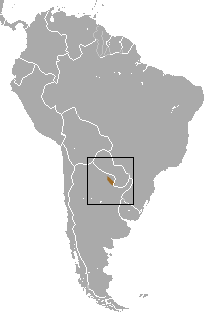
The Chacoan pygmy opossum is a recently described genus and species of didelphimorph marsupial. The only species in Chacodelphys, C. formosa, was known until 2004 from only one specimen collected in 1920 in the Chaco of Formosa Province, Argentina. The species is gaining popularity as a pocket pet.

The dusky caenolestid, also known as Tate's shrew opossum, is a shrew opossum from South America. The dusky caenolestid is characterized by a dark brown coat with a lighter underbelly, soft and thick fur, and a loosely haired tail. A nocturnal animal, the dusky caenolestid lives on trees and feeds on insects and small invertebrates and vertebrates. It occurs in alpine and páramo forests in northern and western Colombia, Ecuador, and western Venezuela. The IUCN classifies this shrew opossum as least concern.

The gray four-eyed opossum is an opossum species from Central and South America, ranging from southern Mexico to Peru, Bolivia and southwestern Brazil, at altitudes from sea level to 1600 m, but generally below 1,000 metres (3,300 ft). Its habitats include primary, secondary and disturbed forest. It is one of many opossum species in the order Didelphimorphia and the family Didelphidae.

The brown-eared woolly opossum, also known as the western woolly opossum, is an opossum from South America. It was first described by German naturalist Ignaz von Olfers in 1818. The opossum is characterized by a brown to reddish brown coat and similarly colored limbs, yellow to orange underbelly, hairless, brown ears with a hint of pink, and a tail furred on the back for up to half of its length. The brown-eared woolly opossum is nocturnal, solitary and omnivorous. The IUCN lists it as least concern.

The black-shouldered opossum, also known as the white-eared opossum, is an opossum known from western Brazil and southeastern Peru. It was first described by Colin Campbell Sanborn, curator of Field Museum of Natural History, in 1951. The black-shouldered opossum is characterized by a gray coat, gray underbelly, and broad black stripes that extend from the forefeet, meet on the shoulders, run along the midline of the back and then split into parallel stripes that run down the hind feet. Little is known of the behavior of the black-shouldered opossum. It is nocturnal and arboreal. It is known to feed on fruits and rodents. The opossum inhabits humid forests. The IUCN classifies it as least concern.

The brown four-eyed opossum is a pouchless marsupial of the family Didelphidae. It is found in different forested habitats of Central and South America, from Nicaragua to Brazil and northern Argentina, including southeastern Colombia, Paraguay and eastern Peru and Bolivia, at elevations from sea level to 1,500 m (4,900 ft). It is the only recognized species in the genus Metachirus, but molecular phylogenetics studies suggest that it should probably be split into several species. Population densities are usually low, and it is uncommon in parts of Central America. A density of 25.6/km2 (66/sq mi) was reported near Manaus, Brazil. Its karyotype has 2n = 14 and FN = 24.
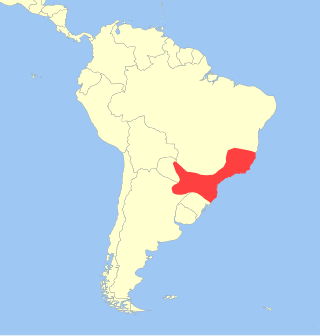
The southeastern four-eyed opossum is an opossum species native to South America. It is found in Atlantic Forest ecoregions, in Brazil, Paraguay and Argentina.

Anderson's four-eyed opossum is an opossum species from South America. It is found in Brazil, Colombia, Ecuador, Peru and Venezuela. Its dorsal fur is dark, with a black stripe, about 3–4 cm wide, going vertically down the midline of its back. Its dorsal fur is short, about 10 mm long. Its ventral fur is dark gray, but still distinctly lighter than the sides and dorsum. Its tail is furred for the first (approximately) 18% of its length, going from the base to the tip. Its species name "andersoni" was chosen to honor American scientific collector Malcolm Playfair Anderson.

Emilia's short-tailed opossum is an opossum species from South America. It is found south of the Amazon River from eastern Peru, through Bolivia, to central Brazil.

The dwarf fat-tailed mouse opossum, also known as the velvety fat-tailed opossum is an opossum species from South America. It is endemic to Brazil, where it is found in cerrado and caatinga habitats. Its head-and-body length is about 141-212 mm, and its tail length is about 73-85 mm. Its diet is 44% arthropods; 75% of its diet consists of animals and animal products. Its ventral fur is entirely gray-based. Its hind foot is less than 14 mm, which is short for the genus.
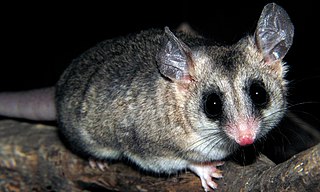
The elegant fat-tailed mouse opossum, also known as the Chilean mouse opossum, is an opossum from central Chile. The type species of Thylamys, it was first described by English naturalist George Robert Waterhouse in 1839. This medium-sized opossum is characterized by black rings around the eyes, white limbs, gray to light brown coat, lighter flanks and underbelly and a thick 12.7–14.6 centimetres (5.0–5.7 in) long tail covered with hairs. It is crepuscular and lives in nests in tree hollows or under rocks and roots. This opossum feeds mainly on arthropods and larvae apart from fruits. Litter size is typically between 11 and 13. The elegant fat-tailed opossum can occur in a variety of habitats – from cloud forests to chaparrals. The IUCN classifies the opossum as least concern.

Thylamys is a genus of opossums in the family Didelphidae. The premaxillae are rounded rather than pointed. The females lack a pouch. The females' nipples are arranged in two symmetrical rows on the abdomen. All species but T. macrurus store fat in their tails., although this is not necessarily true for all species in the genus. Fossils belonging to the genus date back to the Miocene, with the oldest specimens being found in the Cerro Azul Formation of Argentina and the Honda Group of Colombia. Genetic studies indicate that the genus may have originated around 14 million years ago.

The Paraguayan fat-tailed mouse opossum is a species of opossum in the family Didelphidae. It is found in forested areas of Brazil and Paraguay. It is known only from a few specimens. For two listed specimens, one had a head-and-body length of about 135 mm and a tail length of about 140 mm, while the other had a head-and-body length of about 120 mm and a tail length of about 155 mm. Most of its fur is gray, but the shoulder areas are reddish gray, and the ventral fur is pure white or creamy white. There is also a ring of black fur surrounding each eye. The ventral surface of the tail is white. The dorsal surface of the tail is gray for the first one third to one half of its length ; the remainder of the dorsal surface of the tail is white. The tail is hairless except for about its first ten mm. Although the genus Thylamys is characterized by fat storage in the tail, there is no evidence that this species stores fat in its tail.

The white-bellied fat-tailed mouse opossum is a species of opossum in the family Didelphidae. It is found in Argentina, Bolivia, Chile and Peru.
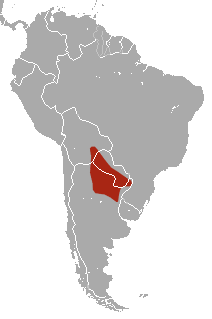
The common fat-tailed mouse opossum is a species of opossum in the family Didelphidae. It occurs in Argentina, Bolivia, and Paraguay in chaco and Andean foothill habitats. Its head-and-body length is about 75 to 120 mm, and its tail length is about 90 to 134 mm. Its dorsal fur is brownish gray, and its ventral fur is yellowish to white. The legs and cheeks are the same color as the ventral surface. Its tail is sharply bicolored. A ring of faintly darker fur surrounds each eye. Its tail often lacks fat deposits, but does not always.

The Cinderella fat-tailed mouse opossum is a species of opossum in the family Didelphidae. It is found in northern Argentina and southern Bolivia, in the eastern foothills of the Andes. Its dorsal fur is gray brown to dark brown. Its ventral fur is gray-based, except for the white to yellowish chest hairs. It has been distinguished from T. sponsorius by the well-developed postorbital ridges of the latter, but mitochondrial DNA sequence analysis does not support separate species status for sponsorius.
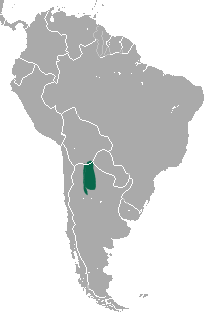
The Argentine fat-tailed mouse opossum was formerly considered a species of opossum in the family Didelphidae. It is found in the eastern foothills of the Andes in northern Argentina and southern Bolivia. Typically reach around 10-13 cm in body length, with a bushy tail adding another 12-15 cm. Its dorsal fur is gray brown to dark brown. Its ventral fur is gray-based except for the white to yellowish chest hairs. It has been distinguished from T. cinderella by its postorbital ridges. T. cinderella has well-developed postorbital ridges in both juveniles and adults that extend laterally behind the eye sockets. Only adults of T. sponsorius have fully developed postorbital ridges, and these do not extend laterally behind the eye sockets. However, mitochondrial DNA sequence analysis does not support the population being distinct from T. cinderella.
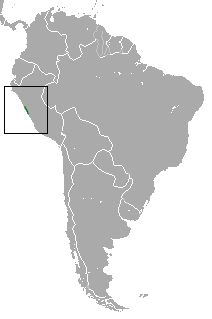
Tate's fat-tailed mouse opossum is a species of opossum in the family Didelphidae, named after American zoologist George Henry Hamilton Tate. It is found at elevations of 300 to 3,000 m along the coast of central Peru. The species has the northernmost range of any member of its genus. It has white ventral fur and short condylobasal and zygomatic lengths. T. pallidior is very similar.

The buff-bellied fat-tailed mouse opossum is a species of opossum in the family Didelphidae. It is found in the transitional and humid forests of northern Argentina and southern Bolivia. Its dorsal fur is cinnamon brown. Most of its ventral fur is gray-based, but its chest, throat, and the thoracic midline are not gray-based. The postorbital ridges are absent in the young and weakly developed in adults.




















